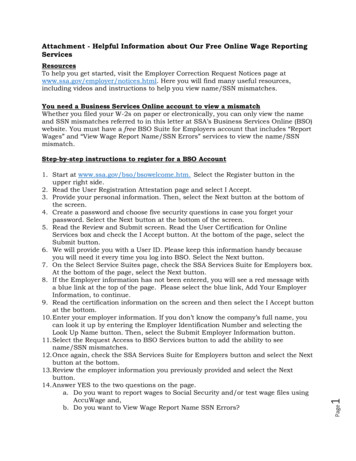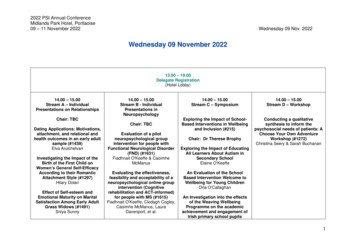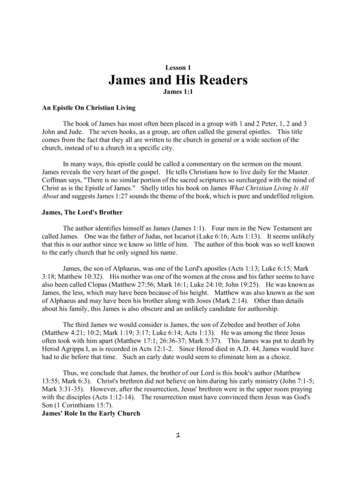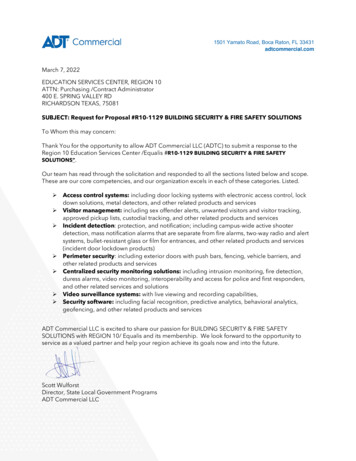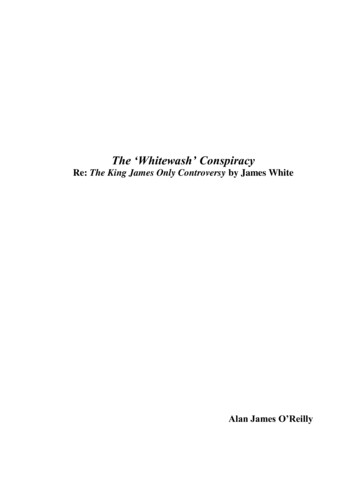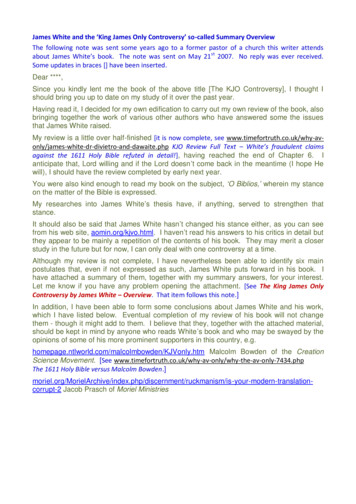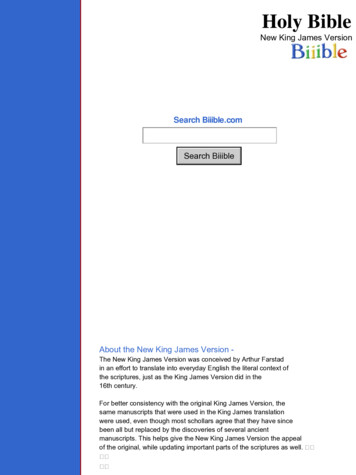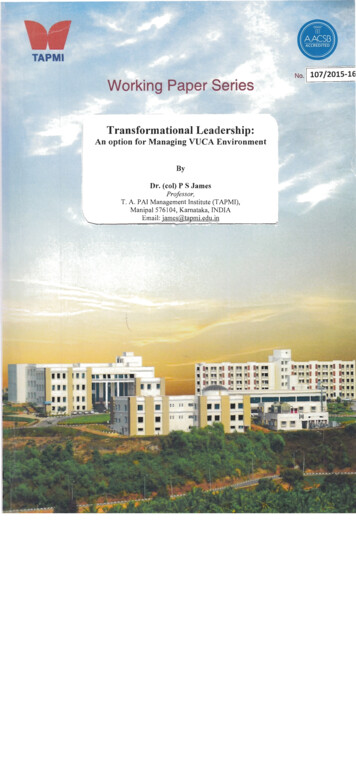
Transcription
TWP: 107 1501Transformational Leadership:An option for Managing VUCA EnvironmentP.S James,Professor,T.A Pai Management Institute,Manipal-576104, Karnataka, IndiaPhone: 0820- 2701058, email: james@tapmi.edu.inAbstractThe acronym VUCA for volatility, uncertainty, complexity and ambiguity typifies the contemporaryenvironment in business. Though the term is increasingly being used, there is no standarddefinition of VUCA. Both academic and practioner literature on VUCA are also sparse. Thisconceptual study examines the relationship between transformational leadership and managingVUCA. The study develops a definition of VUCA and makes propositions to further examine therelationship between the variable of transformational leadership and variables related tomanaging VUCA.Key words: VUCA, Transformational Leadership
James: Transformational Leadership: An Option for Managing VUCA EnvironmentTWP107 1501IntroductionVUCA, the acronym for volatility, uncertainty, complexity and ambiguity emerged from the USWar College (Steim, Judith and Nicholas, 2002) to denote the environment of 21st centurybattlefield known for its rapid changes and fluidity. The framework is apt for the business of todayalso and has been gaining wide acceptance in the business world. While VUCA environment(VUCA) is a well-established term in the management practice circles as evinced from businessconferences, blogs, articles by practioners and consultants and management discussions, it hasreceived little academic attention yet. For instance, when searched using the term ‘VUCA’, GoogleScholar returned only about 2000 results; mostly from practioner literature and a search of theEBSCO database returned only 41 instances including many commentaries. It is still so nascent inthe academic circles that the term does not have an accepted definition to form the basis forresearch.VUCA is not exactly a modern phenomenon, though the term has been in use only for the pastdecade or so. If we go back in time, the case of Krishna leading Arjuna into the battle ofMahabharatha in the Indian mythological literature is a clear example of existence of VUCA andmanaging it. Moses leading the Israelites from the captivity of Egypt narrated in the Bible is yetanother example from the ancient history. Gandhi and Nelson Mandela leading India and SouthAfrica respectively to freedom under such circumstances are relatively modern examples. Morerecently, we have seen Malala speaking up for education of girls in the VUCA of Afghanistan, asa result of which she was dragged off her school bus and shot; only to resurrect like a phoenixfrom the ashes. Though not a new phenomenon, the intensity and frequency of occurrence ofVUCA and its effect on day to day life is surely a modern phenomenon.On the business front we have many examples of the impact of VUCA. Enron and SatyamComputers of India (both do not exist today), prima facie appear to be such ones. The former,whose business model survived on managing volatility and uncertainty of the deregulating marketin energy and other commodities created complex methods for it and despite creating asophisticated risk management technology platform, the company failed to manage the VUCAsuccessfully. The case of Satyam is even more intriguing. In this case, the promoter who was alsothe CEO of the company created accounting frauds which resulted in the organization getting intoa VUCA resulting in sale of the company after a few months of nurturing it under governmentleadership. In both these cases the VUCA was precipitated, if not created, by the leaders throughomissions and commissions.In recent years we have seen a series of cases which prima facie can be considered VUCA. Thenear collapse of the US banks in 2008 and nurturing it by the government and the Eurozone crisismanagement are possible examples of VUCA (I call them possible examples because we still donot have definition to classify them as VUCA).In all the cases discussed above, leadership had an impact, positive or negative, on the creationand outcome of the VUCA environment at firm level. Therefore, it is reasonable to assume thatleadership has an impact on VUCA. Within that assumption, I propose that transformationalleadership would have a better impact on managing VUCA. This is the primary objective of thisstudy. Both VUCA and the factors that affect decision making under VUCA are little researchedareas and this work addresses the knowledge gap in ‘leadership-VUCA relationship’. A relatedTAPMI WORKING PAPER SERIES
James: Transformational Leadership: An Option for Managing VUCA EnvironmentTWP107 1501objective, though secondary, is equally important i.e., to define the term VUCA because it isnecessary for this and future researches.MethodologyThis is a conceptual paper in an environment of paucity of literature. Therefore, I deviate fromthe standard procedure and define my methodology first and then orchestrate the literature.Using dictionary definition of the constituents of VUCA i.e., volatility, uncertainty, complexityand ambiguity, I examine four firm level cases (a holiday Timeshare company in India, Enron,Southwest Airlines and Vodafone India). I confine to firm level instances and do not includeindustry level or national level business environment to limit the variance in the study and notbecause they are any less important. The organizations for the study are carefully selected toinclude 1) both small and big firms, 2) existing and wound up companies, 3) national and globalfirms, and 4) those which have successfully managed VUCA, those which failed to do and thoseendeavoring to do so. Firms selected are ones which are intimately known to the author or thosewhose cases are well documented. From the analysis of these, key characteristics of thecomponents of VUCA are derived and then amalgamated to evolve a definition of VUCA.Then I argue that even in a VUCA environment decisions are taken, even if by heuristics, whereinthe leadership is a key component. I use practioner literature to identify key variables in managingVUCA. I use literature to substantiate my preference for transformational leadership as more suitedto manage VUCA and make propositions on the impact of transformational leadership variableson variables for managing VUCA.Defining VUCAVUCA is still an ill-defined term and there is a tendency to classify every difficult situation asVUCA. This is at least partially the result of lack of a formal definition of the term. Its constituentssuch as volatility, uncertainty, complexity and ambiguity are defined independently and indifferent circumstances and also studied under various disciplines (for instance economicvolatility, financial volatility, Knightian uncertainty etc.). But an integrated and accepted definitionof VUCA is still at large. Therefore, I draw on the dictionary meaning of the constituents of VUCAand examine four firm level cases to identify a pattern. Based on this, a definition of VUCA isproposed.Let us start with the dictionary meaning of its constituent terms. The Oxford dictionary definesvolatility as ‘something liable to change rapidly, especially for the worse. Instability is inherent involatility’. It defines the term uncertain as ‘unknown, undetermined, unpredictable andunforeseeable’. The term complex is defined as ‘something consisting of different and connectedparts and not easy to analyze or understand’. The term ambiguous is defined as ‘something thatis open to more than one interpretation’. Other dictionaries also broadly concur with thesedefinitions. Let us now dwell into each of the constituent components from a business perspective.TAPMI WORKING PAPER SERIES
James: Transformational Leadership: An Option for Managing VUCA EnvironmentTWP107 1501VolatilityVolatility is a well-researched subject in economics and finance. Economic volatility is usuallydefined as the idiosyncratic shocks being greater than aggregate shock (Haltiwanger, 2011).Factors that contribute to it such as business cycles, unemployment, inflation, stabilization policiesand economic growth are well known. Volatility in financial market is also well studied and thereare dozens of techniques to measure and manage them. But there are other types of volatility inthe business world today which are ill defined and many of them affect the firm.To understand this, let us consider what happened in late 1990s and early 2000 in one of the wellknown holiday timeshare companies in India. In those years, it faced unprecedented exodus ofmanpower. Its employees were not moving to another hospitality company, but to the emerginghealthcare sector to man the front office, kitchen, room service and such hospitality related rolesin healthcare. Adept in building its manpower the company faced this challenge commendably;but by mid 2000s it was losing its manpower again and became unstable due to another emergingsector-the mobile telephone industry, which was looking for customer care staff.Can we say that the situation of the holiday timeshare company was volatile? Perhaps we cananswer in the affirmative because there was sudden change for the worse and this fits the definitionwe saw earlier. But it was also unpredictable or uncertain because the linkage between the growthof sunrise sectors such as healthcare and mobile telecommunication and their need for similar skillsfrom another industry could not have been easily predicted because we have insufficientknowledge of 1) the emergence of such sectors, 2) what talent they would need and 3) moreimportantly that they would look at a relatively sleepy sector like hospitality to procure their muchrequired talent. This is also a complex situation because different interconnected aspects such asderegulation of various sectors, investment, location of the emerging industries, similarity of jobroles and shortage of trained manpower in these roles have to be understood before we can makeany prediction. In hindsight, one may be able to understand this but since such events do not repeatthemselves we would not have sufficient data points to identify a pattern. As a result of this, eachsuch event is amenable to interpretation in many ways which makes it ambiguous also. Forinstance, the emergence of healthcare was well discussed in the hospitality sector in the light ofopportunities for health tourism and resorts even initiated discussion for providing post treatmentrecovery facilities in the resorts; but never once did the threat of talent exit enter the strategicdiscussion room of the firm.What manifested as a volatile situation, when analyzed in retrospect, indicates the existence of allother factor of VUCA also which is probably the reason why VUCA situations are often managedinappropriately.UncertaintyIn business uncertainty and risk are two closely related terms; but they are treated differently. Riskis measurable and it is mitigated through hedging, insurance etc. Uncertainty, on the other hand,is the existence of a danger that one is unaware of and more importantly cannot be measured(Knigt, 2012). Though its existence in politics and military where competing forces operatewithout clear laws is well known, it is an entirely new phenomenon in business which is conductedby rule of law. Knight (2012), refers to it as:TAPMI WORKING PAPER SERIES
James: Transformational Leadership: An Option for Managing VUCA EnvironmentTWP107 1501" 'risk' means in some cases a quantity susceptible of measurement, while at other timesit is something distinctly not of this character; and there are far-reaching and crucialdifferences in the bearings of the phenomena depending on which of the two is reallypresent and operating. It will appear that a measurable uncertainty, or 'risk' proper, aswe shall use the term, is so far different from an immeasurable one that it is not in effectan uncertainty at all."To examine this, let us take another familiar case. In 2001, Enron collapsed with a suddennessseldom seen earlier in the business world and brought down its auditors, Arthur Anderson, alongwith it. Everyone knew that the Enron’s business model had high risk, but managing risk was theirdifferentiation in the business of commodities such as energy, water and spectrum. In order tobuild on their differentiation, they recruited the best brains and paid them high and contingentcompensation to do what exactly Enron is good at – take risks. They adopted the ‘mark to market’accounting system based on present value and rewarded the employees based on this. In order tomeasure and control risk, they developed a state of the art information system called RiskTraccapable of factoring in interest rate, time horizon, location, price risk etc. and fine-tuned it usingMonte Carlo simulation. But the system perhaps had no way to capture when a state wouldderegulate its energy and other core sectors, what laws would be in place and so on. So, anotherwise well designed risk tracking system became uncertain because the time of deregulationand the laws governing the deregulation were uncertain.To make the situation worse the business was became very complex based on asset light model inwhich several hundreds of companies were created to hold the assets and make it easy for Enronto show a favorable balance sheet within permissible limits. These companies were often ownedby Enron employees. Though ethics and conflict of interest precautions were taken, it was difficultto state what constituted a conflict of interest because of the complex nature of the holding. Beingin an era of technology, people had blind faith in the RiskTrac. Globalization had created severalinterlinked systems and Enron had invested in several foreign countries with varied laws. All thesemade the Enron system complex. This complexity was created to manage the former challengei.e., uncertainty; rather to convert uncertainty to measureable and manageable risk.A complex system is difficult to understand and hence ambiguity set in. The auditors felt that allis not well in Enron but could not clearly pinpoint any irregularity. Even the highly competentindependent directors found the systems so complex that actions could be interpreted in multipleways. The social sentiments of the era eulogized (this is so even now) risk taking and theambiguous situation led to a positive way of looking at risk and most experts called the Enronsystem as ‘bold and innovative’ rather than ‘dangerous’ although they did not understand itscomplexity.Enron was thus a company that had all the components of VUCA. It perhaps started whenuncertainty was perceived as measurable risk using a technology platform with complexcomponents which no one understood and therefore could be interpreted in multiple ways(ambiguous). As a result, the company became volatile and literally imploded.TAPMI WORKING PAPER SERIES
James: Transformational Leadership: An Option for Managing VUCA EnvironmentTWP107 1501ComplexityAlthough dictionaries tend to define complexity as a state of being intricate or complicated, theconsequences of being complicated and being complex differ. Complicated systems are ones inwhich there are a number of subsystems but they are largely, sequential in interaction which makesit possible to predict outcomes. Complex, on the other hand, is non-linear and therefore thedirection of causality is unknown. As a result, proactive measures and responses are relativelydifficult.To understand this phenomenon better, let us turn to the case of Southwest Airlines (SW) knownfor sustained profit in an environment of losses by other airlines. SW was a new entrant to thederegulated airlines industry and operated in an environment of high fuel price volatility. It lackedairport rights in many important airports and had to rent them at exorbitant cost from otheroperators or operate without touching these hubs on the basis of point to point flights, which wasoperationally inefficient compared to hub and spoke model where people were flown to a centralplace (hub) from smaller places (spoke) and then flown out again to their respective destinations(spoke). Point to point method would normally imply high operating cost compared to seatoccupancy.In order to manage the airlines better, it focused on speedy turnaround of the aircraft. Employeeswere given a work environment full of fun and with the complex HR system (which we now callHigh Performance Work System) they created even the pilots helped in unloading to ensure thespeedy turnaround. In fact SW fun and speedy turnaround was so complex that no other airlinescould mimic it. The complex system that ensured the speedy turnaround (15 minutes versus theaverage 45 minutes) enabled a Southwest aircraft to make at least one additional trip a day whichreduced the impact of fixed costs of the aircraft. Point to point flight to less known airfields madethe turnaround faster and it also make it convenient for passengers, especially the businesstravelers, thereby creating a synergy between the route selection and turnaround and passengerconvenience. Further, SW hedged as much as 70 percent of their fuel as against 20 to 30 percentby the competitors because they saw volatility in the fuel market in the long run. This reduced theirfuel cost to half of what the other airlines paid. The combined synergy of making the trips,including the additional trip, with fuel that cost them less is self-explanatory. Thus the SW systemhad two well managed VUCA components i.e., complexity and volatility.These systems were so complex that people could not interpret it effectively. So, there wasconsiderable ambiguity about what made SW so successful and this ambiguity led to multipleinterpretation of their success – was it point to point, was it fuel hedging, was it fun lovingworkplace? The ambiguity made it difficult to imitate and gave Southwest airlines the competitiveadvantage for many years. This also removed the uncertainty because 1) uncertainty due to lack ofhubs decreased, 2) uncertainty that competitors can create especially through price wars reducedand 3) uncertainty related to retrenching of workers almost became non-existent.SW case is thus a good example of existence of the various components of VUCA and still beingable to manage them proactively.TAPMI WORKING PAPER SERIES
James: Transformational Leadership: An Option for Managing VUCA EnvironmentTWP107 1501AmbiguityAmbiguity is defined as ‘being open to more than one interpretation, inexactness or somethingsusceptible to multiple interpretations. To understand the impact of this, let us take the case ofVodafone India.Indian tax authorities slapped a whooping Rupees 140,000 million (approximately US 2330million) tax cum fine on Vodafone for tax related acquisition of the share of Hutchison Essar, adeal executed in Cayman Islands in 2007. Though Supreme Court of India gave a favorabledecision to Vodafone, the government made a retrospective amendment to the tax policy to recoverthe money (The Economic Times, 2013). The case still hangs fire with the assumption that thegovernment may do a course correction.If we track this incent, we can find that at the time of acquisition, Vodafone had not consideredthe tax laws as ‘ambiguous’. But once the tax authorities issued notice, the issue of taxation becameclearer i.e., the law could have multiple interpretations. It was at this stage the ambiguity wasperhaps discovered. The situation became volatile when the tax authorities issued notice forrecovery and then it made a positive turn when the Supreme Court verdict went in its favor andthen became volatile again when the government passed a retrospective law to recover the taxes.The situation remains uncertain or unpredictable because the government states that it is not infavor of retrospective taxation, but has done nothing about it so far. It is also complex because ofthe position taken by the tax authorities, government department and trade bodies and the need tolook fair and just to both corporate world and the larger public who might perceive revoking theorder a climb down in favor of the corporate at the cost of the citizen. The situation still remainsuncertain.This case too has all the components of VUCA. Though it manifested through a volatile situationwhen the tax authorities slap a recovery cum fine, its roots lie in the ambiguity in law that Vodafonedid not detect.Defining VUCA as a Three Dimensional ModelFrom the foregoing discussion, it is evident that VUCA is a unified phenomenon and needs to beaddressed as such. In other words, all components of VUCA exist together even though the initialmanifestation may be through one of them.A closer scrutiny of VUCA across different types of companies indicates that the phenomenon ispervasive though its intensity and impact may vary. A further look at each of its constituentcomponents reveals some predominant characteristic. In the next few paragraphs we discuss these.Volatility can be perceived as rapid change in the environment in unexpected direction. We sawsuch changes in the Timeshare Company, Enron and Vodfone cases where the direction of changewas quite unexpected. For example increasing salary, competitive pressure etc. are clear directionto predict employee turnover but not emergence of a sunrise sector. Volatility therefore has lackdirection as a key characteristic.Uncertainty refers to unprecedented eruption of external environment in a direction that washitherto considered impossible. For instance a sunrise sector leads to turnover in another sector, anon-existent tax law suddenly props up in the form of a retrospective law and a complex politicoTAPMI WORKING PAPER SERIES
James: Transformational Leadership: An Option for Managing VUCA EnvironmentTWP107 1501economic situation and social acceptance of higher risk leads to undetectable erratic behavior inEnron. Inherent in uncertainty is immeasurability and a lack of awareness of thedanger/opportunity which can be seen in all cases. For instance Enron’s model was considered anopportunity and innovation rather than a danger and its risk could not be measured. Vodafonepurchasing the shares in Cayman Islands was considered an opportunity and the direction of itsconsequences could not be identified. The success of failure of a point to point versus hub andspoke model aviation could not be measured. Thus uncertainty made situation both directionlessand immeasurable.Complexity is the result of multiple interrelated systems which makes it difficult to understand thecausality. In other words, it is difficult to identify what event caused the other. This makes itdifficult or impossible to interpret. This manifests best in Southwest Case. But even in thetimeshare case, the complex emerging economic system made it impossible to predict the causalityof turnover until it happened. This was true in the case of Enron and Vodafone also.Ambiguity is the existence of possibility of multiple interpretations. For instance a discussion onemerging sectors did take place in the strategic meetings of the Timeshare Company when theauthor was a top executive working for it; the discussion revolved around the increasing marketand expansion opportunities rather than on impending massive employee exit. The tax laws inIndia could be interpreted in several ways and so was the risk perception of Enron and theperceived foolhardy point to point system of Southwest airlines. This makes a situation impossibleto interpret.Three key characteristics of VUCA that emerge from the above discussion are 1)‘directionlessness’, 2) ‘immeasurability’ and 3) ‘uninterpretability’. Combining these, the authordefines VUCA as an environment of directionlessness’, ‘immeasurability’ and‘uninterpretability’.Paraphrased, it means that ‘directionlessness’ makes it impossible to extrapolate meaning frompast experience and predictive tools which depend on such data become ineffective and redundantleaving us to heuristics and intuition or perhaps collective wisdom. Immeasurability creates asituation of not knowing what variables one should include and even when they are knownpartially, their combined effect remains unknown leading us to depend more on multiple, andperhaps, diverse views. Uninterpretability creates a situation where causality is not known whichmakes any interpretation useless leading us to a situation where one has to boldly try out variousoptions and then determine whether they work or not.Perspectives on Managing VUCAThough I argue that VUCA is directionless, immeasurable and uninterruptable, I concede that evenin such circumstances decision are (and would be) made; but such decisions are likely to be basedon heuristics. For instance, the managers and the auditors of Enron accepted that the practices theyfollowed were bold and innovative but stopped short of calling it illegal or not permissible. Thiswas a heuristics driven decision. The timeshare company that we discussed decided to train andhold larger manpower than required to face any future challenges of exit due to sunrise sectors andthis affected its profit. Though the decisions were based on heuristics, their impact can be evaluatedretrospectively. For instance, Enron got liquidated and the timeshare company realized that highlevels of exit was never repeated perhaps because several training institutions emerged to trainTAPMI WORKING PAPER SERIES
James: Transformational Leadership: An Option for Managing VUCA EnvironmentTWP107 1501people in skills required for the emerging sectors. Eventually an expansion helped the company toabsorb its surplus manpower created to face the VUCA environment. Similarly despite the setback,Vodafone operates and continues to expand in India and Southwest airlines thrives.While the academic world is still in the process of getting a grip on VUCA, the consulting worldhas been proactive to recommend many suggestions to manage the VUCA world. For instance,FMI Management consulting in its paper on “Redefining Leadership: Strategic Thinking inToday’s VUCA World” makes a series of recommendations such as 1) ability to hold on to thevision while fighting the tactical battles, 2) having tangible closer milestones rather than one grandmilestone, 3) frequent introspection, 4) aggressive action orientation, 5) shifting to networkorganizational architecture from hierarchy, 5) ability to let go the past and focus on the future and6) encouraging individual critical thinking to face the challenge of VUCA (FMI, consulting paper,2013).Johansen and Voto (2013) identify ten leadership skills for the future. These are: 1) maker instinct,2) clarity, 3) dilemma flipping, 4) exceptional learning ability, 5) bio-empathy, 6) constructivedepolarizing, 7) quiet transparency, 8) rapid prototyping, 9) smart mob organizing and 10)commons creating. Out of these, the authors identify five skills as crucial for managing VUCA.The first of this is the maker instinct which implies the inner urge to create communities of makersfor larger impact. Second is clarity which gives the leaders the ability to understand the strategicintent and take actions or operationalize the maker instinct at multiple levels based on theunderstanding of the intent. Third is ‘dilemma flipping’. This means that rather than try to solvethe unsolvable problems, flip them to identify newer opportunities. For instance, workplace woulddemand more freedom and so, rather than work with complex organizational structures that createcontrol-freedom paradigm, one may be able to modularize work and hand it over to entrepreneurialteams. Fourth is smart mob organizing, which means bringing together dissimilar people usingtechnology to solve seemingly irresolvable problem. For instance, it is the smart mob organizingthat led to the change in Egyptian government in 2011. It is once again this mob organizing throughcrowd sourcing that enabled the Indian Civil Servant, Armstrong Pame, make 100 kilometers ofroad in the rural Manipur without any government help (Times of India, 2012). Fifth is bioempathy which is the ability to take systems approach, integrating and sharing approach from thebiological world and creating symbiotic problem solving. The author argues that this needs a‘commons’ approach. It is a concept of increasing dependence on pooled resources, a conceptwhich is well articulated in the work of Nobel laureate, Elinor Ostrom (Ostrom, 1990) also.Coats (2009), argues in support of ‘Arya’ leadership, to manage VUCA. His suggestion is thatleaders should have strong skill of discernment between what is reality and what are merelycaricatures of it. In other words, leaders should be able to distinguish between the real and mereexpression of the real. Of course the concept is rooted in Vedas from India.Horney, Pasmore and O’Shea (2010) developed a leadership agility model to manage VUCA.Their proposition is that leaders in a VUCA environment should be flexible, fast and focused. Theyshould 1) anticipate change through visioning, sensing the changes happening and monitoring, 2)generate confidence through connecting, aligning and engaging, 3) initiate action through showinga clear bias for action, decision making and collaborating, 4) liberate thinking through innovation,TAPMI WORKING PAPER SERIES
James: Transformational Leadership: An Option for Managing VUCA EnvironmentTWP107 1501customer focus (this author prefers to call it stakeholder focus) and idea diversity, and 5) resultorientation through creating expectations, feedback and evidence based measurement.Summarizing the insights from the above works, we can find that managing VUCA involves sixdistinct competencies: 1) introspection through suspension of judgment and ego to identify the realfrom the illusionary, 2) critical and creative thinking facilitated by dilemma flipping and diversityof ideas, 3) clear and focused vision building and adherence to the vision, 4) strong alignment tothe vision rooted in action and resu
James: Transformational Leadership: An Option for Managing VUCA Environment TWP107_1501 TAPMI WORKING PAPER SERIES Introduction VUCA, the acronym for volatility, uncertainty, complexity and ambiguity emerged from the US . recently, we have seen Malala speaking up for education of girls in


